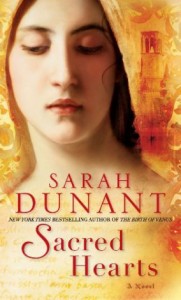 I was riveted to this book. Having read Sarah Dunant’s The Birth of Venus, I hoped this last novel of the trilogy would be as good. I wasn’t disappointed. Sacred Hearts is a powerful account of convent life in the northern Itallian city of Ferrara.
I was riveted to this book. Having read Sarah Dunant’s The Birth of Venus, I hoped this last novel of the trilogy would be as good. I wasn’t disappointed. Sacred Hearts is a powerful account of convent life in the northern Itallian city of Ferrara.
In the late sixteenth century, the price of wedding doweries was so exorbitant that most noble families could afford to marry off only one daughter. The remaining women were dispatched to convents, with doweries to be sure, but much less than for a wedding. Many of these women went against their will. Some adjusted to the rigors of convent life, others chafed at the idea of spending their lives cloistered in a strict environment, following rigid rules, often at the whims and dictates of the outside world.
When sixteen-year-old Serefina is forced into the Santa Caterina convent, ripped from her family and the man she loves, she is beset by rage. She’s a talented young woman, bright and gifted with a thrilling singing voice, but she is determined to never surrender to what she believes to be a place of horrors.
Sister Zuana, the convent’s dispensary mistress and the daughter of a doctor, is sent to sedate the ranting young newcomer. Remembering her early years at Santa Caterina, the older nun becomes a mentor. What follows–the intricate relationship of trust and betrayal–is the story of Sacred Hearts. The Abbess, Madonna Chiara, who commands the convent’s total and unquestioning obedience, plays an important role in the intrigue and complications of life in a shuttered world.
Durant describes convent life in such realistic detail that the reader can feel the chilly dampness of the stone walls and floors, the bone-weariness of 2:00 a.m .prayers, the discipline of imposed fasting, silence, and humiliation. But one also feels the pure acceptance of Christ, the joys of serving, and of being able to exercise one’s talents to benefit sisters of the convent to the glory of God.
Sacred Hearts is an absorbing, meticulously researched novel of historical fiction. Durant gives life to the Renaissance period, particularly of its brutal affect on women.
I highly recommend this book and plan to read the second of the trilogy, In the Company of the Courtesan.

